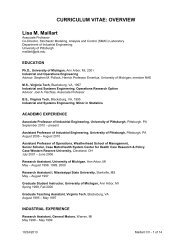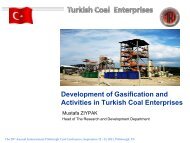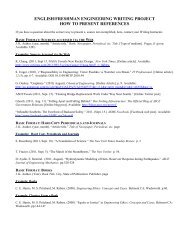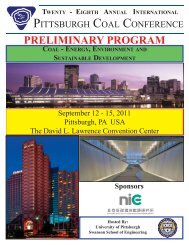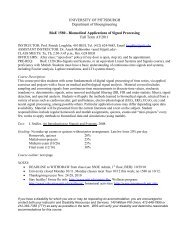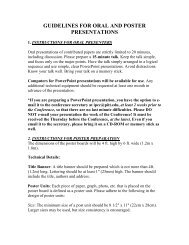Abstract Booklet 2006 - Swanson School of Engineering - University ...
Abstract Booklet 2006 - Swanson School of Engineering - University ...
Abstract Booklet 2006 - Swanson School of Engineering - University ...
Create successful ePaper yourself
Turn your PDF publications into a flip-book with our unique Google optimized e-Paper software.
24-3<br />
Development <strong>of</strong> Fluidizable Lithium Silicate-Based Sorbents for<br />
High Temperature Carbon Dioxide Removal<br />
Weijiong Li, Santosh Gangwal, Raghubir Gupta, Brian S. Turk, RTI International,<br />
USA<br />
One <strong>of</strong> the key features accelerating the commercial deployment <strong>of</strong> integrated<br />
gasification combined cycle (IGCC) systems for producing electricity is that the<br />
addition <strong>of</strong> CO 2 capture and sequestration processes results in the lowest increment in<br />
capital and operating costs <strong>of</strong> any <strong>of</strong> the competing technologies. However, the<br />
commercially available technologies require significant cooling <strong>of</strong> the syngas to<br />
effectively capture the CO 2 that introduces a significant thermodynamic penalty for<br />
CO 2 capture. RTI International (RTI) has been working with regenerable sorbent<br />
materials for CO 2 capture at elevated temperatures with the potential to produce a high<br />
pressure high purity CO 2 product. This process <strong>of</strong>fers the potential to significantly<br />
reduce any thermodynamic penalty associated with the CO 2 capture process. During<br />
the course <strong>of</strong> this research, RTI has developed Li 2 SiO 4 -based sorbents that have<br />
demonstrated CO 2 capture and regeneration in bench-scale testing. Results from this<br />
testing program were presented at last year’s Pittsburgh Coal Conference.<br />
Over the last year, RTI has built upon this success by conducting R&D for a fluidized<br />
Li 4 SiO 4 -based sorbent. The incentive for this work is the knowledge that a transport<br />
reactor system can be designed to treat high gas throughputs at relatively low capital<br />
costs, which will be required to treat the large CO 2 content <strong>of</strong> syngas derived from<br />
carbonaceous fuels, especially coal. A CO 2 capture technology that <strong>of</strong>fers lower capital<br />
cost and higher thermal efficiency becomes more commercially attractive with the<br />
potential reward <strong>of</strong> earlier implementation. The technical challenges for developing a<br />
fluidized Li 4 SiO 4 sorbent are to achieve a high CO 2 reactivity, acceptable<br />
hydrodynamic properties and suitable attrition resistance. This presentation will<br />
describe the progress made in this R&D program.<br />
24-4<br />
Carbon Dioxide Separation through Supported Ionic<br />
Liquids Membranes in Polymeric Matrixes<br />
Jeffery Ilconich, David Luebke, Christina Myers, Henry Pennline, DOE/NETL, USA<br />
As compared to other gas separation techniques, membranes have several advantages which<br />
can include low capital cost, relatively low energy usage and scalability. While it could be<br />
possible to synthesize the ideal polymer for membrane separation <strong>of</strong> carbon dioxide from<br />
fuel gas, it would be very intensive in terms <strong>of</strong> money and time. Supported liquid<br />
membranes allow the researcher to utilize the wealth <strong>of</strong> knowledge available on liquid<br />
properties. Ionic liquids, which can be useful in capturing CO 2 from fuel gas because they<br />
posses high CO 2 solubility in the ionic liquid relative to H 2 , are an excellent candidate for<br />
this type <strong>of</strong> membrane. Ionic liquids are not susceptible to evaporation due to their negligible<br />
vapor pressure and thus eliminate the main problem typically seen with supported liquid<br />
membranes.<br />
A study has been conducted evaluating the use <strong>of</strong> the ionic liquid 1-hexyl-3-methylimidazolium<br />
bis(trifuoromethylsulfonyl)imide in supported ionic liquid membranes for the<br />
capture <strong>of</strong> CO 2 from streams containing H 2 . In a joint project, the ionic liquid was<br />
synthesized and characterized at the <strong>University</strong> <strong>of</strong> Notre Dame, incorporated into a<br />
polymeric matrix, and tested at the National Energy Technology Laboratory. Initial results<br />
have been very promising with calculated CO 2 permeabilities as high as 950 barrers and<br />
significant improvements in CO 2 /H 2 selectivity over the unmodified polymer at 37°C along<br />
with promising results at elevated temperatures. In addition to performance, the study<br />
included examining the choice <strong>of</strong> polymeric supports on performance and membrane<br />
stability in more realistic operating conditions. Also included in this study was an evaluation<br />
<strong>of</strong> novel approaches to incorporate the ionic liquid into polymer matrices to optimize the<br />
performance and stability <strong>of</strong> the membranes.<br />
24-5<br />
A Parametric Study for Regenerative Ammonia-Based<br />
Scrubbing for the Capture <strong>of</strong> CO 2<br />
Kevin Resnik, James T. Yeh, Henry W. Pennline, DOE/NETL, USA<br />
William Garber, Deborah C. Hreha, Parsons Project Services, Inc., USA<br />
A continuous gas and liquid flow, regenerative scrubbing process for CO 2 capture is<br />
currently being demonstrated at the bench-scale level. An aqueous ammonia-based<br />
solution captures CO 2 from simulated flue gas in an absorber and releases a nearly pure<br />
stream <strong>of</strong> CO 2 in the regenerator. After the regeneration, the solution <strong>of</strong> ammonium<br />
compounds is recycled to the absorber. The design <strong>of</strong> the continuous flow unit was<br />
based on earlier exploratory results from a semi-batch reactor, where a CO 2 and N 2 gas<br />
mixture flowed through a well-mixed batch <strong>of</strong> ammonia-based solution. Recently, a<br />
series <strong>of</strong> tests have been conducted on the continuous unit to observe the effect <strong>of</strong><br />
various parameters on CO 2 removal efficiency and regenerator effectiveness within the<br />
flow system. The parameters that were studied include absorber temperature,<br />
regenerator temperature, initial NH 3 concentration, simulated flue gas flow rate, liquid<br />
solvent inventory in the flow system, and height <strong>of</strong> the packed-bed absorber. Results<br />
from this current testing campaign conducted in the continuous scrubbing unit as well<br />
as test results from a 5-cycle semi-batch reactor will be discussed.<br />
25-1<br />
SESSION 25<br />
GASIFICATION TECHNOLOGIES:<br />
ADVANCED SYNTHESIS GAS CLEANUP – 2<br />
Synthesis and Reactivity Test <strong>of</strong> Nanostructure ZnO for<br />
Hot Gas Cleanup on the IGFC<br />
Si Ok Ryu, No-Kuk Park, You Jin Lee, Gi Bo Han, Tae Jin Lee, Yeungnam<br />
<strong>University</strong>, SOUTH KOREA<br />
Chih Hung Chang, Oregon State <strong>University</strong>, USA<br />
A nano-size zinc oxide was formulated for the effective removal <strong>of</strong> a very low concentration<br />
<strong>of</strong> sulfur compounds (H 2 S, COS) contained in a gasified fuel gas and their reactivity was<br />
also investigated in this study. They were prepared by a matrix-assisted method with various<br />
precursors. An active carbon was used for a matrix and zinc nitrate, zinc acetate, zinc<br />
chloride, and zinc sulfate were selected as precursors. Zinc nitrate was the best precursor for<br />
the formulation <strong>of</strong> the nano-size zinc oxide in the experiments. The size <strong>of</strong> the formulated<br />
nano-size zinc oxides was in the range <strong>of</strong> 20-30 nm and its surface area was about 56.2 m 2 /g.<br />
From TGA(thermal gravity analysis) test, it was found that its sulfur absorption rate was<br />
about 0.363 gS/min·100 g-sorbent. Their reactivity increased with the smaller size and the<br />
larger surface area <strong>of</strong> the sorbents. Most prepared nano-size zinc oxides showed an excellent<br />
performance for the removal <strong>of</strong> not only H 2 S but also COS. Their absorption rate was faster<br />
than commercial zinc oxides. In order to investigate the sulfur absorption characteristics <strong>of</strong><br />
zinc oxide, a series <strong>of</strong> experiments for various nano-size zinc oxides formulated from<br />
different precursors were carried out in a packed-bed reactor system over the temperature<br />
500°C. The sulfur capacity was about 5.83 gS/100 g-sorbent for H 2 S. It was concluded that<br />
the zinc oxide prepared by zinc nitrate as a precursor showed the highest sulfur removing<br />
capacity.<br />
25-2<br />
Desulfurization <strong>of</strong> High-Pressure Gasified Coal Using the<br />
UC Sulfur Recovery Process<br />
Diana Matonis, Howard S. Meyer, Dennis Leppin, Gas Technology Institute, USA<br />
The <strong>University</strong> <strong>of</strong> California Sulfur Recovery Process – High Pressure (UCSRP-HP)<br />
provides the potential to treat high-pressure, warm synthesis gas for the removal <strong>of</strong><br />
ammonia, hydrogen chloride, and heavy metals including arsenic, mercury, cadmium, and<br />
selenium as well as essentially all <strong>of</strong> the hydrogen sulfide and carbonyl sulfide in a coalderived<br />
synthesis gas in a compound contacting tower. In the bottom or scrub section <strong>of</strong> the<br />
tower, the sour gas feed is contacted with a solvent that will absorb some steady state levels<br />
<strong>of</strong> water, ammonia, and hydrogen sulfide from the gas stream. As a result, the HCl content<br />
<strong>of</strong> the feed gas will be absorbed very effectively to form highly soluble NH 4 Cl. A small but<br />
significant concentration <strong>of</strong> NH 4 HS will also be present in the liquid phase, and the heavy<br />
metals As, Cd and Hg, will be absorbed to form their respective, very insoluble sulfides.<br />
Selenium, present in the syngas as H 2 Se, will be absorbed to form highly soluble (NH 4 ) 2 Se.<br />
The solvent is recirculated with a small slipstream being withdrawn, perhaps intermittently,<br />
for filtration and other treatment to remove the accumulated impurities and then returned.<br />
The gas stream leaving the scrub section passes into the reactor section through a chimney<br />
that effectively prevents the mixing <strong>of</strong> the solvent in the two sections. In the upper or reactor<br />
section <strong>of</strong> the tower, the UCSRP-HP uses a solvent with high capacity for H 2 S and SO 2 that<br />
also catalyzes the liquid-phase reaction <strong>of</strong> H 2 S and SO 2 to sulfur and water. Operation is<br />
above the melting point <strong>of</strong> sulfur, so the sulfur forms a separate liquid phase and is removed<br />
by simple decantation. The now scrubbed, sour gas, mixed with 10% − 20% excess SO 2 , is<br />
contacted at high pressure (the higher the better) with the UCSRP solvent at about 260 −<br />
285°F (125 – 140°C). Substantially all <strong>of</strong> the H 2 S reacts to form liquid sulfur, leaving the<br />
excess SO 2 in the treated gas. The unreacted SO 2 is recovered in a separate absorber/stripper<br />
system, which may optionally also serve to dry the treated gas. The sulfur-free gas may<br />
optionally also be passed through a second absorber/stripper system for CO 2 recovery. The<br />
recovered SO 2 is combined with SO 2 produced by burning one-third <strong>of</strong> the liquid sulfur in a<br />
furnace, compressed and perhaps liquefied, and fed to the reactor column. The furnace<br />
employs either air or oxygen. All <strong>of</strong> the sulfur formed in the reactor is vaporized as it passes<br />
through the furnace; the unburned two-thirds condense in the waste-heat boiler. Any organic<br />
components dissolved in the sulfur will also be burned. The product sulfur has only a small<br />
amount <strong>of</strong> dissolved SO 2 as impurity. This paper will discuss the experimental and<br />
engineering studies <strong>of</strong> UCSRP-HP for syngas desulfurization with optional CO 2 recovery<br />
that include laboratory studies on vapor liquid equilibrium, solvent stability, corrosion and<br />
kinetic studies performed in laboratory scale equipment and column scale-up testing in<br />
bench-scale apparatus conducted at GTI and will highlight the potential economic benefits <strong>of</strong><br />
the process.<br />
25-3<br />
Sorbents for Mercury Capture from Fuel Gas with<br />
Application to Gasification Systems<br />
Evan Granite, Henry W. Pennline, Christina R. Myers, Dennis C. Stanko, DOE/NETL,<br />
USA<br />
21



